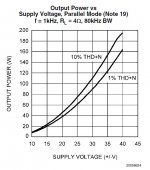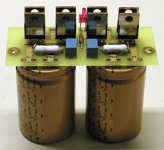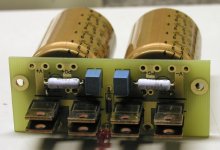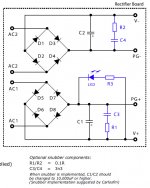I'm embarking on my first amplifier build with two of the Audiosector LM4780 gainclone kits. Each kit contains 2 boards and 2 LM4780 chips.
My first kit is configured right now for stereo operation. That is, 2 channels of amplification from each chip/board for a total of 4 channels. The speakers are all 4 ohm impedance loads per channel. I planned to use a 400VA 18+18 transformer for this kit.
The second kit, I would like to maximize the available power, and use 2 channels output only. The reason for this is that they will drive woofers. Based on what I have been reading in the threads, each chip can be "paralleled" to run one channel instead of two. How much power does this yield? (Does it double the 60w rating, making 120w?)Also, does it require having a balanced source to run in parallel mode(which I dont have)?
I planned on using another 400VA 18+18 transformer for this as these are 4ohm loads as well.
Any advice or input you can offer is greatly appreciated. I've read through many of the threads but I havent found exactly what I was looking for. THANKS !
My first kit is configured right now for stereo operation. That is, 2 channels of amplification from each chip/board for a total of 4 channels. The speakers are all 4 ohm impedance loads per channel. I planned to use a 400VA 18+18 transformer for this kit.
The second kit, I would like to maximize the available power, and use 2 channels output only. The reason for this is that they will drive woofers. Based on what I have been reading in the threads, each chip can be "paralleled" to run one channel instead of two. How much power does this yield? (Does it double the 60w rating, making 120w?)Also, does it require having a balanced source to run in parallel mode(which I dont have)?
I planned on using another 400VA 18+18 transformer for this as these are 4ohm loads as well.
Any advice or input you can offer is greatly appreciated. I've read through many of the threads but I havent found exactly what I was looking for. THANKS !
Please read this article first: Amplifier Power Ratings
The amplifier's power will depend on supply voltage, available current and load impedance. Assuming first two parameters don't change, the power will double when moving from 8 ohm speakers to 4ohm.
To maximize power from LM4780 kit, you need to use voltage supply close to maximum allowable rating, which is +/-40V. While with a single amp inside LM4780 chip (half of the chip as used in stereo mode) that would be not a good idea as amp would not be able to produce enough current, connecting 2 amps in parallel should be fine and you will be able to get 120W. The transformer should be at least 25v + 25v.
Parallel is when you have inputs and outputs of both amps connected together, and for that you do not need balanced source.
Bridged is recommended for 8 ohm loads, and can be compared to both amps connected in series, where you feed each amp section with opposite polarity signal and the output is taken from "between" the amps with no reference to ground. Read page 7 of this manual for more info: http://www.firstwatt.com/downloads/f4_om.pdf
The amplifier's power will depend on supply voltage, available current and load impedance. Assuming first two parameters don't change, the power will double when moving from 8 ohm speakers to 4ohm.
To maximize power from LM4780 kit, you need to use voltage supply close to maximum allowable rating, which is +/-40V. While with a single amp inside LM4780 chip (half of the chip as used in stereo mode) that would be not a good idea as amp would not be able to produce enough current, connecting 2 amps in parallel should be fine and you will be able to get 120W. The transformer should be at least 25v + 25v.
Parallel is when you have inputs and outputs of both amps connected together, and for that you do not need balanced source.
Bridged is recommended for 8 ohm loads, and can be compared to both amps connected in series, where you feed each amp section with opposite polarity signal and the output is taken from "between" the amps with no reference to ground. Read page 7 of this manual for more info: http://www.firstwatt.com/downloads/f4_om.pdf
Attachments
Last edited:
Please read this article first: Amplifier Power Ratings
The amplifier's power will depend on supply voltage, available current and load impedance. Assuming first two parameters don't change, the power will double when moving from 8 ohm speakers to 4ohm.
To maximize power from LM4780 kit, you need to use voltage supply close to maximum allowable rating, which is +/-40V. While with a single amp inside LM4780 chip (half of the chip as used in stereo mode) that would be not a good idea as amp would not be able to produce enough current, connecting 2 amps in parallel should be fine and you will be able to get 120W. The transformer should be at least 25v + 25v.
Man, I feel like a 3rd grader taking algebra 😛 Sorry for the beginner questions. I just want to be sure I complete this properly and use the right parts.
Ok, lets see if I have this right-
On each of your kits, there are two amp boards, one chip per board. On each board there is the option to have two outputs(Left and right), OR a single (parallel) output(mono), by following the wiring schematic. By wiring one of these boards to be parallel (mono) and by using 4ohm speaker impedance, I should expect to get 120 watts. Is that correct?
I will use the single 400VA 25+25 transformer as you recommended to supply both of these parallel (mono) boards.
Thank god its Friday. I need a beer. 😱
Thank god its Friday. I need a beer. 😱
You deserve a beer for graduating to 4th grade. 😉
..todd
You deserve a beer for graduating to 4th grade. 😉
..todd
😀
Im supposed to be in 5th...my parents held me back...honest
An externally hosted image should be here but it was not working when we last tested it.
An externally hosted image should be here but it was not working when we last tested it.
An externally hosted image should be here but it was not working when we last tested it.
Good to go. Now Im just waiting on the transformers and remaining parts.
Looks like each amp board only has a 1500uF smoothing cap per rail.
For the intended use i.e. mono bass into a 4ohm load, wouldn't it be smart to increase that? Maybe an extra 4700uF or even 10000uF per rail connected between the rectifier board and the amp board?
For the intended use i.e. mono bass into a 4ohm load, wouldn't it be smart to increase that? Maybe an extra 4700uF or even 10000uF per rail connected between the rectifier board and the amp board?
That's a good point and certainly worth trying. There are dedicated pads on rectifier board to mound additional caps. Some people also prefer to use snubbers when there's more capacitance and there's also space on board for those parts. However, using 1500uF is a good starting point and you may not necessarily like more caps.
Pictures show LM3875 PS board and for LM4780 the layout is very similar (although diodes mounting is reversed).
Pictures show LM3875 PS board and for LM4780 the layout is very similar (although diodes mounting is reversed).
Attachments
Thanks for the tips. I'll try it as is first and then if bass performance needs improving, I'll add some 4700uF-10,000uF caps on each c1/c2.
Even with that extra capacitance added, the snubber components are still optional as well, yes?
Even with that extra capacitance added, the snubber components are still optional as well, yes?
Yes, snubbers are optional. Generally they supposed to improve definition of bass when large caps are being used. In a long run I found them too manipulative to a sound.
Some additional comments here:
http://www.diyaudio.com/forums/chip...ut-any-comments-suggestions-8.html#post581230
http://www.diyaudio.com/forums/digi...gate-caps-out-production-so-2.html#post574431
Some additional comments here:
http://www.diyaudio.com/forums/chip...ut-any-comments-suggestions-8.html#post581230
http://www.diyaudio.com/forums/digi...gate-caps-out-production-so-2.html#post574431
Nice blue boards, Peter. Can I trade in my old gold ones for blue ones? [kidding!]
..Todd
The quality of these boards is quite good. And they look great too 😉
Since I will be using both the stereo 4 channel amp and the 2 channel parallel amp with 4ohm speakers, I was planning on going a little different route with the cooling. Instead of using the supplied insulator film between chip and heatsink, I'm going to isolate the heatsinks from the chassis and attach the chips direct to the heatsink (with compound of course). I'm thinking this should provide at least slightly more effective cooling.
My plan is to use (2) rackmount cases, 3U size and put 2 pieces of aluminum heatsink in each one run parallel with each other. Each piece will cool one chip. Heatsink size for each chip is 10" x 3.5" x 2". Fins are 1.9" tall and .08" thick with a base thats 0.4" thick. I'm also considering picking up a small piece of copper bar between the chip and aluminum...might be overkill though.
The heatsink material can be seen here: It would be cut in half to provide the sizes needed. Heat Sink DIY HiFi Amplify Kit IGBT Cooling 10"x7"x2" - eBay (item 250577005422 end time Feb-14-10 21:05:14 PST)
The rackmount case can be seen here: http://cgi.ebay.com/3U-Audio-Rackmo...lectrical_Equipment_Tools?hash=item5633f61111
One transformer per case, I dont think there will be any issues with fitting everything in there 🙂
Last edited:
LM4780 Parallel mode
Hi Peter,
From your LM4780 kit, what has to be changed to run it in Parallel mode?
Thanks
Do
Hi Peter,
From your LM4780 kit, what has to be changed to run it in Parallel mode?
Thanks
Do
You will find all the info here: http://www.diyaudio.com/forums/audio-sector/155635-kit-arrived.html
Bridge mode?
Yeah! me again...! 😀
Do you also have instructions for bridge mode. Must be pretty similar to parallel mode.
Thanks
Do
Yeah! me again...! 😀
Do you also have instructions for bridge mode. Must be pretty similar to parallel mode.
Thanks
Do
Bridged mode is the same as stereo version described here: http://www.diyaudio.com/forums/audi...chip-amp-kits-dacs-chassis-13.html#post636565
Use green option on schematic here: http://audiosector.com/lm4780 amp.pdf
Please note that the amp won't convert unbalanced signal to balanced. You can use transformers for that purpose: http://www.diyaudio.com/forums/audi...kit-building-instructions-22.html#post1712724
Use green option on schematic here: http://audiosector.com/lm4780 amp.pdf
Please note that the amp won't convert unbalanced signal to balanced. You can use transformers for that purpose: http://www.diyaudio.com/forums/audi...kit-building-instructions-22.html#post1712724
Unbalanced to balanced
Hi Peter,
I was thinking about using a BurrBrown DRV134. What do you think about that?
Using a transfo, I would need a really good quality one in order to not alter the sound.
Do you have an example of what you would use as a very good quality transfo for this purpose at Mouser or Digikey or Parts Connexion...
This is an example I was able to find but don't know if it is a good choice or if I can find this in Canada. Don't know how to implement it either for both XLR and SE as input...
DIY BPA300 v2 6x LM3886 300W audio Amplifier
Thanks
Do
Hi Peter,
I was thinking about using a BurrBrown DRV134. What do you think about that?
Using a transfo, I would need a really good quality one in order to not alter the sound.
Do you have an example of what you would use as a very good quality transfo for this purpose at Mouser or Digikey or Parts Connexion...
This is an example I was able to find but don't know if it is a good choice or if I can find this in Canada. Don't know how to implement it either for both XLR and SE as input...
DIY BPA300 v2 6x LM3886 300W audio Amplifier
Thanks
Do
- Status
- Not open for further replies.
- Home
- More Vendors...
- Audio Sector
- Getting confused with LM4780 "parallel" and "bridged"



